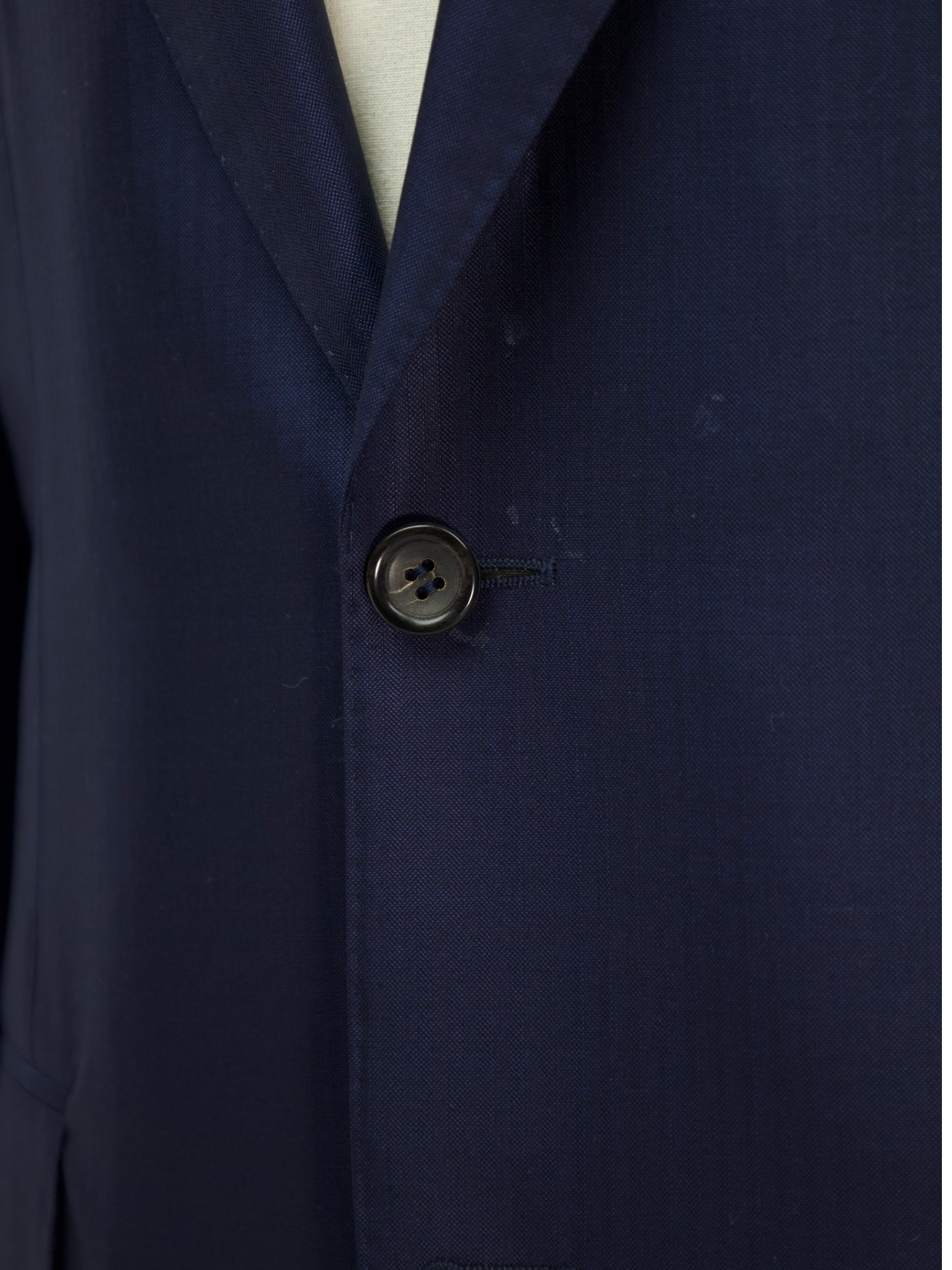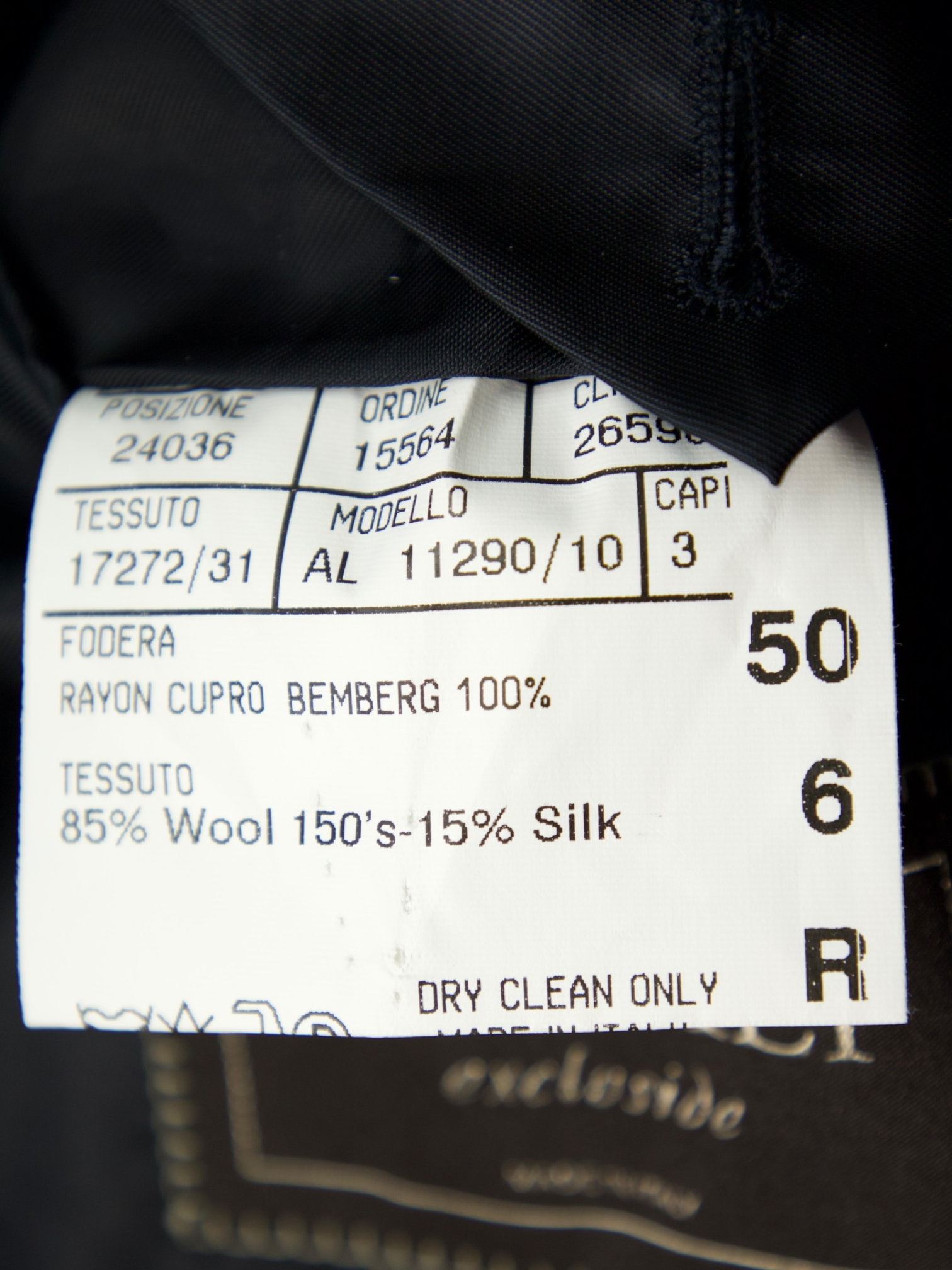






Canali Neapolitan Blue Super 150's & Silk Herringbone Suit
50 IT / 40 US / Large
Discover the Canali Neapolitan Blue Super 150's & Silk Herringbone Suit, a masterclass in luxury tailoring and refined Italian style. This suit is crafted from an exquisite blend of Super 150's "Exclusive" wool and silk, offering an incredibly smooth and lightweight fabric with a soft, lustrous finish. The Neapolitan blue hue adds a touch of sophistication, while the herringbone pattern provides a classic texture with a modern edge.
Handmade in Canali's renowned Italian workshops, this suit reflects the brand's dedication to meticulous craftsmanship and high-quality materials. The jacket features notch lapels, a single-breasted closure, and a tailored silhouette that flatters the wearer's form. The trousers are designed with a sleek cut to ensure a cohesive and polished look, perfect for both formal occasions and upscale business settings.
The combination of Super 150's wool and silk ensures not only a luxurious feel but also a fabric that drapes beautifully and maintains its structure. This suit embodies Canali's tradition of creating garments that are both timeless and effortlessly elegant. Discover the elaborated sartorial details below.
Composition: "Exclusive" 85% Wool / 15% Silk
Color: Neapolitan
Pattern: Herringbone
See how we measure our sartorial items
Discover the customization possibilities by visiting our tailor alteration guide
Shipping
- Complimentary shipping on orders over €200 (Netherlands), €500 (EU), and €1,000 (rest of world).
- Orders under these amounts: shipping rates depend on your country.
- Customs duties or import fees may apply and are the customer’s responsibility. The courier may charge additional fees.
Returns
- You have the right to return your order within 14 days of delivery.
- If you wish to return an item, please notify us within 48 hours of receiving your order.
- Return shipping is at the customer’s expense.
- A 10% restocking fee will be deducted from your refund for all returns.
Please carefully review all measurements and quality control notes in the listing before purchasing. Return shipments have an environmental and economic impact. For any questions or if you need help, feel free to contact us before placing your order.
General Note: While we inspect each item to ensure its quality, please note that minor imperfections may be present due to the preloved nature of the garments. We strive to represent every item accurately, but subtle signs of wear may sometimes go unnoticed. We appreciate your understanding and commitment to sustainable luxury.
Choose options








Discover the
Sartorial Details

Full Canvas Construction
A sartorial jacket - or coat - needs an interlining that will help give it shape and mold it. Canvas gives the item a tailored and crafted look. In short, it breathes life into it. Purely technical, canvas is made from either horsehair, wool, mohair or camel hair. It could also be a mix of them all, with varying thickness and weight. The canvas is stitched to the jacket, often by hand, thus making the canvas pieces 'floating' in the middle of the inner and outer cloth. This gives the jacket added flexibility. The canvas runs from the upper parts, all the way down to the end of the jacket. After you wear your canvassed suit for a while, it will begin to take your shape and look incredibly natural.

Soft Shoulders
Soft Shoulders, or lightly padded shoulder construction, gives a softer, more casual silhouette to a tailored jacket. Soft shoulders have little padding and follow the contour of the individual’s shoulder to accentuate the wearer’s natural features.

Buttonhole
The buttonhole on the lapel of a jacket, traditionally found on the left side, is a classic feature rooted in both functionality and decoration. Historically, it served a practical purpose, allowing gentlemen to fasten the lapel to the opposite side for extra protection against cold weather or to secure a boutonnière, a decorative flower. While its functional use has largely diminished in modern times, the lapel buttonhole remains a staple of formal and semi-formal menswear, often used to add a touch of elegance with the addition of a boutonnière for special occasions.

Two-Button Closure
The jacket has a two-button closure which keeps the profile neat.

Barchetta Chest Pocket
The barchetta chest pocket is not only curved and blunted, as in the southern Italian style, but the corner is rounder right off.

Darts
The tailors adds two darts - think of them as pinched seams - to ensure the jacket’s body achieves a slim silhouette. The process, called mezzo punto riprese, is done entirely by hand.

Horn Buttons
Horn buttons are prized for their quality. They are made with the finest genuine horn material, improving the appearance of the suit. And because they are so strong, you don't have to worry about them cracking or breaking.

Flap Pockets
This was originally supposed to keep debris from getting into jacket pockets when worn in the country. Flap pockets occupy a sort of middle ground in terms of formality: they are the main choice for business suits, but they can also appear on sport coats as a testament to their casual origins.
the details of
the trousers

Flat Front
Flat-front trousers are a go-to for a modern, clean look. They became popular in the 1960s and 1970s when fashion started leaning towards simpler, more streamlined styles. Unlike pleated pants, flat fronts have no extra fabric at the waist, giving them a sleek appearance that's perfect for a slimmer silhouette. They fit right into both casual and business casual settings, making them incredibly versatile. As a result, they are a favorite for anyone looking to maintain a contemporary vibe in their wardrobe.

Belt Loops
Belt loops are the most common type of waistband found on trousers, providing the option to wear a belt for both style and practicality. Typically spaced evenly around the waistband, belt loops are a versatile feature that can accommodate a wide range of belt styles and sizes. This traditional waistband design is found in everything from casual jeans to formal dress pants, making it a timeless and adaptable option for any wardrobe. Belt loops offer the flexibility to customize your look while ensuring a secure fit.

Plain, Blind Hem
The plain, blind hem is a sophisticated and subtle finishing technique that provides a clean and polished look to trousers. This type of hem involves folding the fabric under and securing it with stitches that are nearly invisible from the outside, creating a smooth and uninterrupted line. It is a popular choice for dress trousers and formalwear, where maintaining a seamless appearance is key. The plain, blind hem combines the simplicity of a plain hem with the elegance of hidden stitching, making it ideal for professional and elegant attire.


size
50 IT / 40 US / Large


 Curator's Description
Curator's Description Materials
Materials